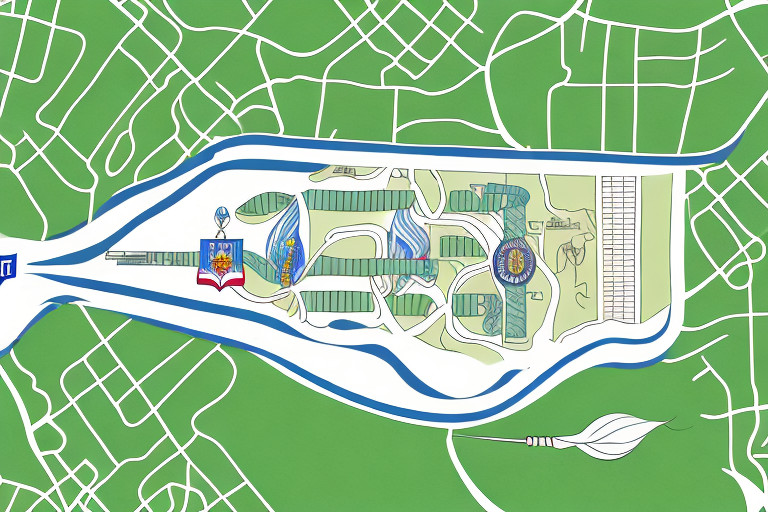Camp Lejeune Water Litigation: An In-Depth Analysis and Its Far-Reaching Implications
Camp Lejeune, the United States Marine Corps base in North Carolina, has been at the center of an extensive legal battle surrounding water contamination. The history of the Camp Lejeune water contamination is a complex issue that has far-reaching implications for both the affected individuals and the responsible parties involved in the case.

The History of Camp Lejeune Water Contamination
In the middle of the 20th century, residents of Camp Lejeune began to experience health issues that were later attributed to contaminated drinking water. The contamination stemmed from various sources, including leaking underground storage tanks and the disposal of hazardous materials.
From the 1950s to the 1980s, thousands of military personnel, their families, and civilian employees unknowingly consumed contaminated water. The adverse effects of this exposure have been well-documented and include an increased risk of several diseases, such as various cancers, birth defects, and neurological disorders.
As news of the water contamination at Camp Lejeune spread, it sparked outrage and concern among the affected community. People wanted answers and justice for the harm they had suffered. Investigations were launched to determine the extent of the contamination and its long-term effects on the health of those exposed.
One of the main sources of the contamination was the leaking underground storage tanks that were used to store various chemicals and fuels. Over time, these tanks deteriorated, leading to the release of toxic substances into the groundwater. The contaminated groundwater then made its way into the drinking water supply, affecting anyone who consumed it.
In addition to the leaking storage tanks, the disposal of hazardous materials also contributed to the water contamination at Camp Lejeune. Improper handling and disposal of these substances resulted in their seepage into the soil and eventually into the groundwater. This further compounded the issue and increased the level of contamination in the drinking water supply.
The health effects of the contaminated water were devastating. Numerous studies have linked the exposure to various types of cancer, including leukemia, breast cancer, and bladder cancer. The risk of birth defects among children born to parents exposed to contaminated water was also significantly higher. Neurological disorders, such as Parkinson's disease and cognitive impairments, were also observed among those who consumed the contaminated water.
Efforts were made to address the water contamination issue at Camp Lejeune. The affected buildings were connected to a municipal water supply, and measures were taken to reduce the exposure to contaminated groundwater. However, the damage had already been done, and many individuals had already been exposed to the toxic substances for years.
The legacy of the Camp Lejeune water contamination continues to be felt today. The affected individuals and their families continue to struggle with the long-term health effects, and many have sought compensation for their suffering. The incident serves as a stark reminder of the importance of proper handling and disposal of hazardous materials and the need for comprehensive monitoring and testing of drinking water supplies.
The Master Docket
The Camp Lejeune water litigation has been consolidated into a master docket, which serves as the centralized location for all the related cases. This consolidation allows for a more efficient legal process, as it eliminates duplication and streamlines the handling of common issues.
The master docket, with its comprehensive collection of cases, serves as a testament to the magnitude and complexity of the Camp Lejeune water contamination issue. Each case represents a story of individuals and families affected by the toxic chemicals that infiltrated their lives.
Within the master docket, lawyers and legal teams meticulously gather evidence, testimonies, and expert opinions to build compelling arguments on behalf of their clients. The docket becomes a repository of information, a treasure trove of facts and narratives that weave together into a tapestry of injustice.
Moreover, the master docket plays a crucial role in facilitating coordination among the parties involved. Attorneys from different firms, representing plaintiffs and defendants, come together to discuss strategies, exchange information, and negotiate potential settlements. This collaborative effort fosters a sense of unity and purpose, as legal professionals work towards a common goal – seeking justice for those affected by the Camp Lejeune water contamination.
For the stakeholders involved in the litigation, the master docket serves as a lifeline of information. It provides easy access to pertinent details, enabling attorneys, plaintiffs, and defendants to stay informed about the progress of individual cases, legal precedents, and emerging developments. The docket becomes a compass, guiding all parties through the intricate maze of legal proceedings.
As the master docket grows in size, it becomes a testament to the tireless efforts of legal professionals who strive to navigate the complexities of the Camp Lejeune water litigation. Consolidating cases within the master docket ensures a more efficient legal process and fosters a sense of collective purpose, as each case contributes to the larger narrative of seeking justice and accountability.
Ultimately, the master docket serves as a testament to the resilience of the individuals and families affected by the Camp Lejeune water contamination. It symbolizes their determination to fight for their rights and hold responsible parties accountable for the harm caused. Within the master docket, their stories find a voice, their struggles find validation, and their pursuit of justice finds a path forward.
The role of the United States Magistrate Judge
An integral part of the Camp Lejeune water litigation is the involvement of the United States Magistrate Judge. The magistrate judge plays a crucial role in overseeing the master docket and ensuring that all parties comply with the court's orders and procedures.
But what does it mean to oversee the master docket? This task involves managing and organizing all the cases related to the Camp Lejeune water litigation. The magistrate judge carefully reviews each case, ensuring that they are properly categorized and assigned to the appropriate judges. This meticulous process helps streamline the legal proceedings and ensures that no case falls through the cracks.
Furthermore, the magistrate judge is not just a passive observer but an active participant in the litigation process. They are responsible for resolving discovery disputes, which can often arise when one party requests information from another and disagreements arise on what should be disclosed. The magistrate judge carefully reviews the arguments from both sides and makes a fair and impartial decision, ensuring that the discovery process remains smooth and efficient.
Additionally, the magistrate judge takes charge of scheduling hearings. This involves coordinating with all the parties involved, including the attorneys, witnesses, and experts, to find a suitable date and time for the hearing. They must consider various factors, such as the availability of the courtrooms, the parties' schedules, and any other logistical considerations. By effectively managing the scheduling process, the magistrate judge helps ensure that the litigation moves forward without unnecessary delays.
Another important responsibility of the magistrate judge is managing pretrial proceedings. This includes overseeing the exchange of information between the parties, conducting pretrial conferences, and facilitating settlement discussions. The magistrate judge acts as a neutral intermediary, guiding the parties towards a resolution while also ensuring that their rights are protected and that the proceedings are conducted in accordance with the law.
In summary, the involvement of the United States Magistrate Judge in the Camp Lejeune water litigation is crucial for the fair and efficient administration of justice. From overseeing the master docket to resolving discovery disputes, scheduling hearings, and managing pretrial proceedings, the magistrate judge plays a pivotal role in ensuring that the litigation progresses smoothly. Their expertise and dedication contribute to the timely resolution of the cases, providing all parties involved a sense of justice and closure.
Motion for Permission to File in the Master Docket
When filing a case related to Camp Lejeune water contamination, parties must seek permission to file their claims in the master docket. This motion helps maintain the integrity and coherence of the consolidated litigation, preventing the duplication of efforts and ensuring consistent treatment of similar cases.
The process of seeking permission involves demonstrating that the claims are related to the Camp Lejeune water contamination and that inclusion in the master docket would facilitate the resolution of the case. Once granted permission, the case becomes part of the larger litigation and benefits from the streamlined procedures.
Motion for a Consolidated Case Management Order and Extension
To further streamline the litigation, parties may file a motion for a consolidated case management order and extension. This motion aims to consolidate any related cases and establish a uniform set of procedures and deadlines for the entire litigation.
A consolidated case management order reduces administrative burden, eliminates confusion, and ensures fairness. Parties benefit from the clear guidelines, which promote efficient handling of the cases and facilitate communication among the parties involved.
Role in streamlining complex litigation
The consolidation of the Camp Lejeune water litigation into a master docket has been instrumental in streamlining the complex nature of the cases. By centralizing all related claims, the master docket is a one-stop location for handling common issues, coordinating actions, and promoting efficiency.
The consolidation process reduces duplicative efforts, minimizes conflicting outcomes, and encourages cooperation among the parties and their legal representation. This streamlined approach allows for a more focused and expeditious resolution of the cases, benefiting all stakeholders.
Benefits for both parties and the court
Consolidating the Camp Lejeune water litigation into a master docket provides numerous benefits for both parties and the court. For the plaintiffs, the consolidation offers a more streamlined and coordinated approach to seeking justice and compensation for their injuries.
By consolidating similar claims, the court can efficiently manage the complex litigation, ensuring equitable treatment and timely resolution. The master docket allows for a more holistic understanding of the issues at hand, reducing the potential for inconsistent outcomes and promoting judicial efficiency and fairness.
Contamination sources and responsible parties
The Camp Lejeune water contamination resulted from various sources, including leaking underground storage tanks and improperly disposal of hazardous materials. These activities occurred over a considerable period, contributing to the severity and duration of the contamination.
Multiple parties have been identified as responsible for the contamination, including the Department of Defense and private companies contracted to provide services on the base. Holding the responsible parties accountable is crucial to the ongoing litigation, ensuring that justice is served and appropriate remedies are provided to the affected individuals.
Negligence claims
A significant aspect of the Camp Lejeune water litigation revolves around negligence claims. Individuals seek to establish that the responsible parties failed to exercise reasonable care in preventing and addressing the contamination, resulting in the detrimental health effects suffered by those exposed to the contaminated water.
These negligence claims focus on demonstrating that the defendants breached their duty of care, thereby causing harm to the plaintiffs. Successful negligence claims may entitle the affected individuals to compensation for medical expenses, pain and suffering, and other related damages.
Strict liability claims
In addition to negligence claims, strict liability claims play a role in the Camp Lejeune water litigation. Strict liability holds the responsible parties liable for the harm caused, regardless of their level of negligence or fault.
In asserting strict liability, plaintiffs seek to establish that the defendants engaged in inherently dangerous activities or products that resulted in water contamination. This approach can simplify the burden of proof for the plaintiffs and ensure that the responsible parties are held accountable for their actions or omissions.
The Camp Lejeune water litigation has become a complex legal battle with significant implications. By consolidating cases into a master docket, the court aims to streamline the litigation process and promote efficiency in resolving the claims.
This litigation seeks to provide justice and appropriate compensation to the affected individuals by holding the responsible parties accountable for the water contamination. The negligence and strict liability claims further underscore the need for accountability and the pursuit of remedies for the harm caused.
As the litigation progresses, it will continue to shape the legal landscape surrounding water contamination cases and serve as a precedent for future actions seeking justice and compensation for similar issues.
If you feel like you may have a claim, use the form on this page to seek help from a qualified legal counselor.




